In spite of her French name, Lucy Doraine (1898-1989) was a Hungarian actress and a major star of the Austrian and German cinema in the 1920s. When she moved to Hollywood, the revolution of the sound film finished her career.

German postcard by Ross Verlag, no. 572/2, 1919-1924. Publicity still for Sodom und Gomorrha/Queen of Sin and the Spectacle of Sodom and Gomorrah (Michael Curtiz a.k.a. Mihály Kertész, 1922).
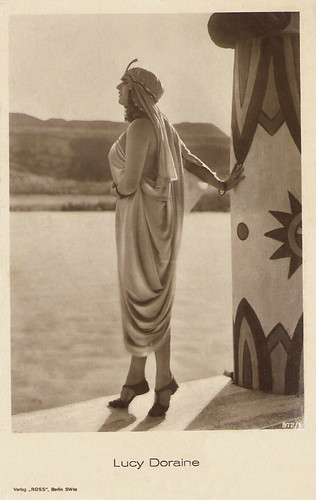
German postcard by Ross Verlag, Berlin, no. 572/1, 1919-1924. Publicity still for Sodom und Gomorrha/Queen of Sin and the Spectacle of Sodom and Gomorrah (Michael Curtiz a.k.a. Mihály Kertész, 1922).

German postcard by Ross Verlag, Berlin, no. 542/4, 1919-1924. Photo: Alex Binder / Foreign Pictures.
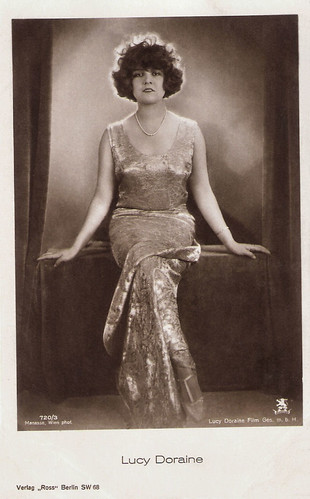
German postcard by Ross Verlag, Berlin, no. 720/3, 1925-1926. Photo: Manassé, Wien / Lucy Doraine Film Ges. m.b.H.

German postcard by Ross Verlag, Berlin, no. 1546/2, 1927-1928. Photo: Atelier Schneider, Berlin.
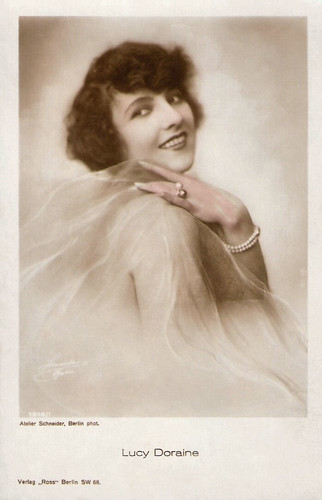
German postcard by Ross Verlag, Berlin, no. 1548/1, 1927-1928. Photo: Atelier Schneider, Berlin.
Lucy Doraine was born Ilonka Kovacs Perenyi in Budapest, Hungary in 1898.
Italian film historian Vittorio Martinelli wrote in 'Le dive del silenzio' (2001) that she was the daughter of a highly placed civil servant, Baron Perenyi, but IMDb and Wikipedia state that she had the more common name of Kovacs. Filmportal.de indicates her double name.
In her teens, Ilonka showed her skills as a piano player, and she attended the actors school Association of Hungarian Actors.
When she was 18, Ilonka started to play small roles in films like A napraforgós hölgy/The Sunflower Woman (Mihaly Kertesz, 1918).
Like most of her early films, it was directed by her future husband, Mihaly Kertesz. Eventually, he would become the famous Hollywood director Michael Curtiz, the maker of such classics as Casablanca (1942) and Mildred Pierce (1945).
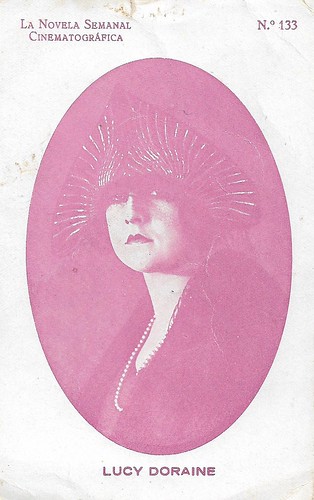
Spanish postcard by La Novela Semanal Cinematográfica, no. 133.
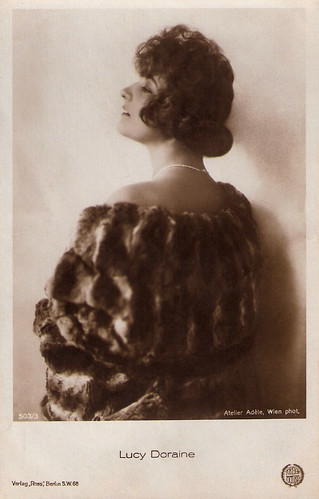
German postcard by Ross Verlag, Berlin, no. 503/3, 1919-1924. Photo: Atelier Adèle, Wien / Foreign Pictures.
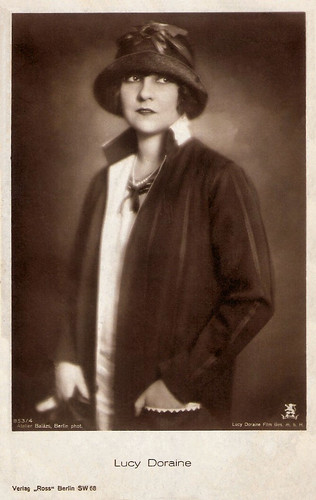
German postcard by Ross Verlag, Berlin, no. 853/4, 1919-1924. Photo: Attelier Balasz, Berlin / Lucie Doraine Film Gmbh.
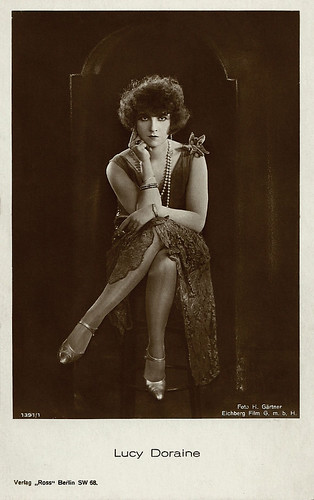
German postcard by Ross Verlag, Berlin, no. 1391/1, 1927-1928. Photo H. Gärtner / Eichberg-Film. Doraine only made one film for Eichberg Film, Der Prinz und die Tänzerin (1926).
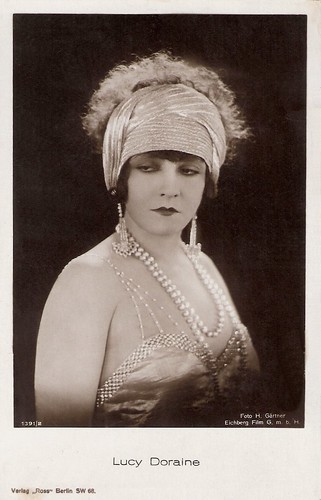
German postcard by Ross Verlag, no. 1391/2, 1927-1928. Photo: H. Gärtner / Eichberg Film GmbH. Doraine only made one film for Eichberg Film, so this card must be for Der Prinz und die Tänzerin (1926). Her name and the name of her film company are often misspelled as Dorraine.
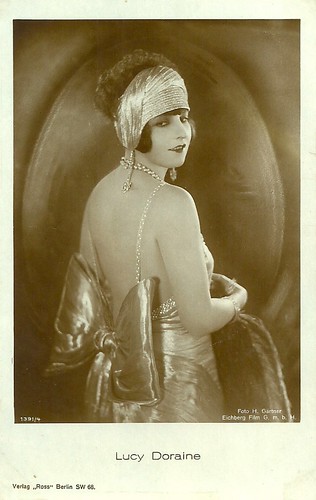
German postcard by Ross Verlag, no. 1391/4, 1927-1928. Photo: Gärtner / Eichberg Film GmbH.

German postcard by Ross Verlag, Berlin, no. 1397/2, 1927-1928. Photo: Alex Binder.
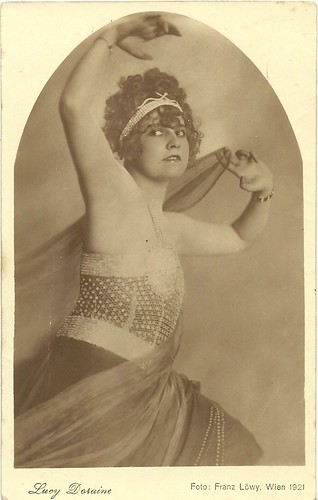
Austrian postcard. Photo: Franz Löwy, Wien (Vienna), 1921. Collection: Didier Hanson.
After the fall of Bela Kun’s Republic and because of the turmoils of 1918-1919, Mihaly and Ilonka Kertesz fled Hungary and took refuge in Vienna. There they both got a contract by Count Kolowrat, the owner of Sascha Film. Their first film in Vienna was Der Dame mit den schwarzen Handschuh/The Lady with the Black Gloves (Mihaly Kertesz, 1919). This was a fruitful period for Austrian cinema, enforced by the contributions of another Hungarian refugee, Alexander Korda.
Ilonka took the stage name of Lucy Doraine and played in witty comedies by her husband, one even more brilliant than the other. These comedies include Miss Tutti Frutti (Mihaly Kertesz, 1921) and Herzogin Satanella/Cherchez la femme! (Mihaly Kertesz, 1921), in which she always starred opposite the Austrian actor Alphons Fryland.
Kertesz excelled in demonstrating his wife’s comic talents, but she also showed she was able to play serious, dramatic roles in Der Stern von Damaskus/The Star of Damascus (Mihaly Kertesz, 1920) and in particular in his monumental super-production Sodom und Gomorrha/Queen of Sin and the Spectacle of Sodom and Gomorrah (Mihaly Kertesz, 1922).
In Der Stern von Damaskus, Doraine played opposite the Hungarian star Iván Petrovich. In Sodom und Gomorrah, she played a triple role: Mary Conway, Lot's wife and the Queen of Syria. Her co-stars were Richard Berczeller, Victor Varconi and Walter Slezak.
Lucy Doraine made 10 films with her husband between 1918 and 1923. She became known for her enticing, ‘risqué’ image. Though in the early 1920s Austria had a hard time exporting to the countries that had won the First World War, Vittorio Martinelli indicates that Doraine’s films were ‘Frenched’ to avoid Italian boycotts: film titles were made French, if they did not already sound so, like Cherchez la femme!
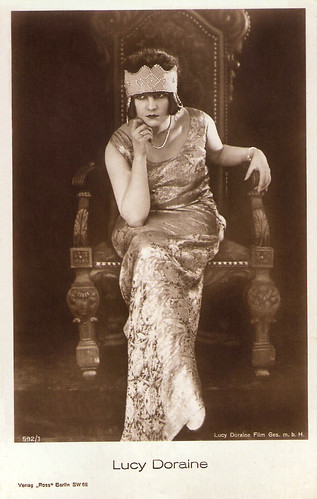
German postcard by Ross Verlag, Berlin, no. 592/1, 1919-1924. Photo: Lucy Doraine Film Ges. m.b.H.
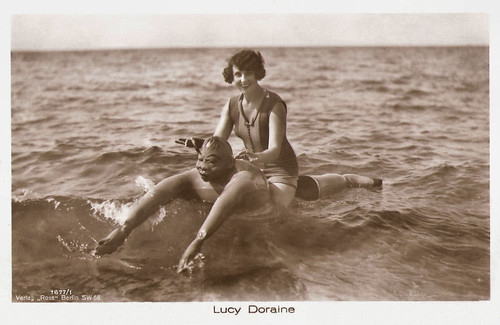
German postcard by Ross Verlag, Berlin, no. 1677/1, 1927-1928.
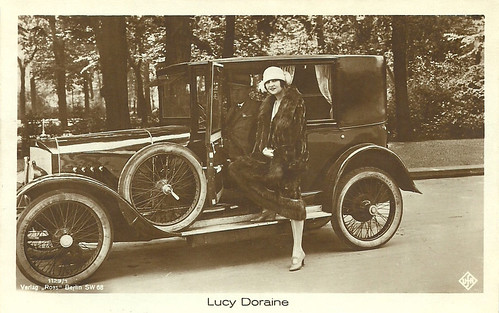
German postcard by Ross Verlag, Berlin, no. 1129/1, 1927-1928. Photo: Ufa. Collection: Didier Hanson.

German postcard by Ross Verlag, Berlin, no. 1212/1, 1927-1928. Photo: Atelier Schneider, Berlin.
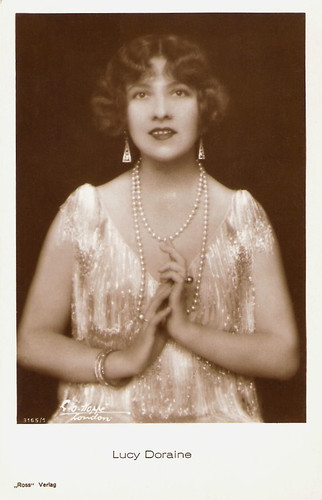
German postcard by Ross Verlag, Berlin, no. 3165/1, 1928-1929. Photo: C.O. Hoppé, London.

German postcard by Ross Verlag, Berlin, no. 3165/2, 1928-1929. Photo: C.O. Hoppé, London.

German postcard by Ross Verlag, Berlin, no. 3295/1, 1928-1929. Photo: C.O. Hoppé, London.
After Lucy Doraine divorced Kertesz in 1923, she moved to Munich. There she worked for the Emelka studio in Opfer der Liebe/Sacrifice for Love (Martin Hartwig, 1923) and for Messter-Ostermayr in Um ein Weibes Ehre/A Wife's Honour (Rudolf Biebrach, 1923) and Gehetzte Menschen/Hunted Men (Erich Schönfelder, 1924) with Johannes Riemann.
Around 1923, she founded in Munich her own company, Lucy Doraine-Film GmbH, for which she produced one film by Rudolf Biebrach, Die suchende Seele/The Searching Soul (1923) and three films directed by Felix Basch: Schicksal/Fate (1924), Finale der Liebe/Love's Finale (1925), Der Mann seiner Frau/His Wife's Husband (1925). In the meantime, she continued to play in films by other companies such as Messter-Ostermayr, or Eichberg-Film in Der Prinz und die Tänzerin/The Prince and the Dancer (Richard Eichberg, 1926) opposite Hans Albers.
Like so many European actors, Doraine was invited to come to Hollywood, in this case by First National in 1927. German First National had been the distributor of her last two German films Eheskandal im Hause Fromont jun. und Risler sen./Mariage Scandal in the Fromont Jr. and Risler Sr. Homes (A.W. Sandberg, 1927) and Alpentragödie/Alp Tragedy (Robert Land, 1927).
However, her American career dwindled down soon when sound film arrived. After supporting roles in the Billy Dove vehicle Adoration (Frank Lloyd, 1928) and the Janet Gaynor vehicle Christina (William K. Howard, 1929), Lucy was only allowed a bit part in Hell’s Angels (Howard Hughes, 1930).
Her last part was a supporting role in Mordprozeß Mary Dugan (Arthur Robison, 1931), the German version of The Trial of Mary Dugan (1931). Hereafter she withdrew from the film business, at the age of 33. Lucy Doraine died at the high age of 91 in Los Angeles, in 1989.
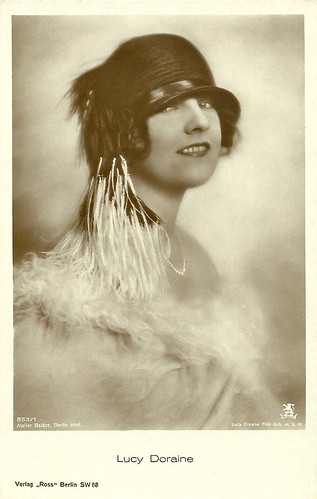
German postcard by Ross Verlag, no. 853/1, 1925-1926. Photo: Atelier Balazs, Berlin / Lucy Doraine Film GmbH. Collection: Didier Hanson.

German postcard by Ross Verlag, no. 994/3, 1925-1926. Photo: d'Ora, Vienna.

German postcard by Ross Verlag, no. 1212/3, 1927-1928. Photo: Atelier Schneider, Berlin.
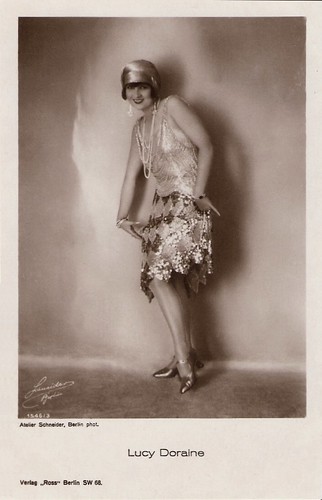
German postcard by Ross Verlag, no. 1546/3, 1927-1928. Photo: Atelier Schneider, Berlin.
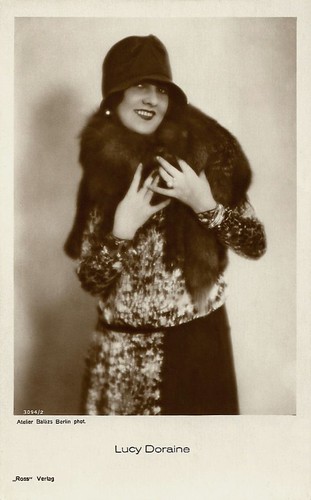
German postcard by Ross Verlag, no. 3054/2, 1928-1929. Photo: Atelier Balazs, Berlin.

German postcard by Ross Verlag, no. 3438/1, 1928-1929. Photo: Alex Binder, Berlin.

German postcard by Ross Verlag, no. 3438/2, 1928-1929. Photo: Alex Binder.
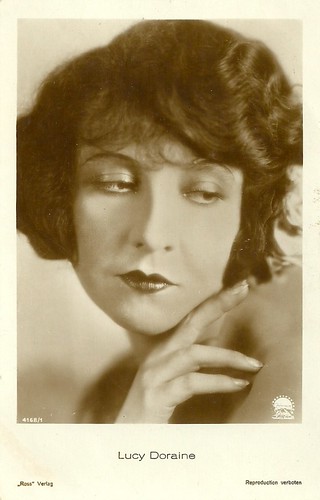
German postcard by Ross Verlag, no. 4168/1, 1929-1930. Photo: Paramount.
Sources: Vittorio Martinelli (Le dive del silenzio - Italian), IMDb, Wikipedia and Filmportal.
This post was last updated on 20 January 2024.

German postcard by Ross Verlag, no. 572/2, 1919-1924. Publicity still for Sodom und Gomorrha/Queen of Sin and the Spectacle of Sodom and Gomorrah (Michael Curtiz a.k.a. Mihály Kertész, 1922).

German postcard by Ross Verlag, Berlin, no. 572/1, 1919-1924. Publicity still for Sodom und Gomorrha/Queen of Sin and the Spectacle of Sodom and Gomorrah (Michael Curtiz a.k.a. Mihály Kertész, 1922).

German postcard by Ross Verlag, Berlin, no. 542/4, 1919-1924. Photo: Alex Binder / Foreign Pictures.

German postcard by Ross Verlag, Berlin, no. 720/3, 1925-1926. Photo: Manassé, Wien / Lucy Doraine Film Ges. m.b.H.

German postcard by Ross Verlag, Berlin, no. 1546/2, 1927-1928. Photo: Atelier Schneider, Berlin.

German postcard by Ross Verlag, Berlin, no. 1548/1, 1927-1928. Photo: Atelier Schneider, Berlin.
Double name
Lucy Doraine was born Ilonka Kovacs Perenyi in Budapest, Hungary in 1898.
Italian film historian Vittorio Martinelli wrote in 'Le dive del silenzio' (2001) that she was the daughter of a highly placed civil servant, Baron Perenyi, but IMDb and Wikipedia state that she had the more common name of Kovacs. Filmportal.de indicates her double name.
In her teens, Ilonka showed her skills as a piano player, and she attended the actors school Association of Hungarian Actors.
When she was 18, Ilonka started to play small roles in films like A napraforgós hölgy/The Sunflower Woman (Mihaly Kertesz, 1918).
Like most of her early films, it was directed by her future husband, Mihaly Kertesz. Eventually, he would become the famous Hollywood director Michael Curtiz, the maker of such classics as Casablanca (1942) and Mildred Pierce (1945).

Spanish postcard by La Novela Semanal Cinematográfica, no. 133.

German postcard by Ross Verlag, Berlin, no. 503/3, 1919-1924. Photo: Atelier Adèle, Wien / Foreign Pictures.

German postcard by Ross Verlag, Berlin, no. 853/4, 1919-1924. Photo: Attelier Balasz, Berlin / Lucie Doraine Film Gmbh.

German postcard by Ross Verlag, Berlin, no. 1391/1, 1927-1928. Photo H. Gärtner / Eichberg-Film. Doraine only made one film for Eichberg Film, Der Prinz und die Tänzerin (1926).

German postcard by Ross Verlag, no. 1391/2, 1927-1928. Photo: H. Gärtner / Eichberg Film GmbH. Doraine only made one film for Eichberg Film, so this card must be for Der Prinz und die Tänzerin (1926). Her name and the name of her film company are often misspelled as Dorraine.

German postcard by Ross Verlag, no. 1391/4, 1927-1928. Photo: Gärtner / Eichberg Film GmbH.

German postcard by Ross Verlag, Berlin, no. 1397/2, 1927-1928. Photo: Alex Binder.

Austrian postcard. Photo: Franz Löwy, Wien (Vienna), 1921. Collection: Didier Hanson.
Risque image
After the fall of Bela Kun’s Republic and because of the turmoils of 1918-1919, Mihaly and Ilonka Kertesz fled Hungary and took refuge in Vienna. There they both got a contract by Count Kolowrat, the owner of Sascha Film. Their first film in Vienna was Der Dame mit den schwarzen Handschuh/The Lady with the Black Gloves (Mihaly Kertesz, 1919). This was a fruitful period for Austrian cinema, enforced by the contributions of another Hungarian refugee, Alexander Korda.
Ilonka took the stage name of Lucy Doraine and played in witty comedies by her husband, one even more brilliant than the other. These comedies include Miss Tutti Frutti (Mihaly Kertesz, 1921) and Herzogin Satanella/Cherchez la femme! (Mihaly Kertesz, 1921), in which she always starred opposite the Austrian actor Alphons Fryland.
Kertesz excelled in demonstrating his wife’s comic talents, but she also showed she was able to play serious, dramatic roles in Der Stern von Damaskus/The Star of Damascus (Mihaly Kertesz, 1920) and in particular in his monumental super-production Sodom und Gomorrha/Queen of Sin and the Spectacle of Sodom and Gomorrah (Mihaly Kertesz, 1922).
In Der Stern von Damaskus, Doraine played opposite the Hungarian star Iván Petrovich. In Sodom und Gomorrah, she played a triple role: Mary Conway, Lot's wife and the Queen of Syria. Her co-stars were Richard Berczeller, Victor Varconi and Walter Slezak.
Lucy Doraine made 10 films with her husband between 1918 and 1923. She became known for her enticing, ‘risqué’ image. Though in the early 1920s Austria had a hard time exporting to the countries that had won the First World War, Vittorio Martinelli indicates that Doraine’s films were ‘Frenched’ to avoid Italian boycotts: film titles were made French, if they did not already sound so, like Cherchez la femme!

German postcard by Ross Verlag, Berlin, no. 592/1, 1919-1924. Photo: Lucy Doraine Film Ges. m.b.H.

German postcard by Ross Verlag, Berlin, no. 1677/1, 1927-1928.

German postcard by Ross Verlag, Berlin, no. 1129/1, 1927-1928. Photo: Ufa. Collection: Didier Hanson.

German postcard by Ross Verlag, Berlin, no. 1212/1, 1927-1928. Photo: Atelier Schneider, Berlin.

German postcard by Ross Verlag, Berlin, no. 3165/1, 1928-1929. Photo: C.O. Hoppé, London.

German postcard by Ross Verlag, Berlin, no. 3165/2, 1928-1929. Photo: C.O. Hoppé, London.

German postcard by Ross Verlag, Berlin, no. 3295/1, 1928-1929. Photo: C.O. Hoppé, London.
From Munich to Hollywood
After Lucy Doraine divorced Kertesz in 1923, she moved to Munich. There she worked for the Emelka studio in Opfer der Liebe/Sacrifice for Love (Martin Hartwig, 1923) and for Messter-Ostermayr in Um ein Weibes Ehre/A Wife's Honour (Rudolf Biebrach, 1923) and Gehetzte Menschen/Hunted Men (Erich Schönfelder, 1924) with Johannes Riemann.
Around 1923, she founded in Munich her own company, Lucy Doraine-Film GmbH, for which she produced one film by Rudolf Biebrach, Die suchende Seele/The Searching Soul (1923) and three films directed by Felix Basch: Schicksal/Fate (1924), Finale der Liebe/Love's Finale (1925), Der Mann seiner Frau/His Wife's Husband (1925). In the meantime, she continued to play in films by other companies such as Messter-Ostermayr, or Eichberg-Film in Der Prinz und die Tänzerin/The Prince and the Dancer (Richard Eichberg, 1926) opposite Hans Albers.
Like so many European actors, Doraine was invited to come to Hollywood, in this case by First National in 1927. German First National had been the distributor of her last two German films Eheskandal im Hause Fromont jun. und Risler sen./Mariage Scandal in the Fromont Jr. and Risler Sr. Homes (A.W. Sandberg, 1927) and Alpentragödie/Alp Tragedy (Robert Land, 1927).
However, her American career dwindled down soon when sound film arrived. After supporting roles in the Billy Dove vehicle Adoration (Frank Lloyd, 1928) and the Janet Gaynor vehicle Christina (William K. Howard, 1929), Lucy was only allowed a bit part in Hell’s Angels (Howard Hughes, 1930).
Her last part was a supporting role in Mordprozeß Mary Dugan (Arthur Robison, 1931), the German version of The Trial of Mary Dugan (1931). Hereafter she withdrew from the film business, at the age of 33. Lucy Doraine died at the high age of 91 in Los Angeles, in 1989.

German postcard by Ross Verlag, no. 853/1, 1925-1926. Photo: Atelier Balazs, Berlin / Lucy Doraine Film GmbH. Collection: Didier Hanson.

German postcard by Ross Verlag, no. 994/3, 1925-1926. Photo: d'Ora, Vienna.

German postcard by Ross Verlag, no. 1212/3, 1927-1928. Photo: Atelier Schneider, Berlin.

German postcard by Ross Verlag, no. 1546/3, 1927-1928. Photo: Atelier Schneider, Berlin.

German postcard by Ross Verlag, no. 3054/2, 1928-1929. Photo: Atelier Balazs, Berlin.

German postcard by Ross Verlag, no. 3438/1, 1928-1929. Photo: Alex Binder, Berlin.

German postcard by Ross Verlag, no. 3438/2, 1928-1929. Photo: Alex Binder.

German postcard by Ross Verlag, no. 4168/1, 1929-1930. Photo: Paramount.
Sources: Vittorio Martinelli (Le dive del silenzio - Italian), IMDb, Wikipedia and Filmportal.
This post was last updated on 20 January 2024.
No comments:
Post a Comment